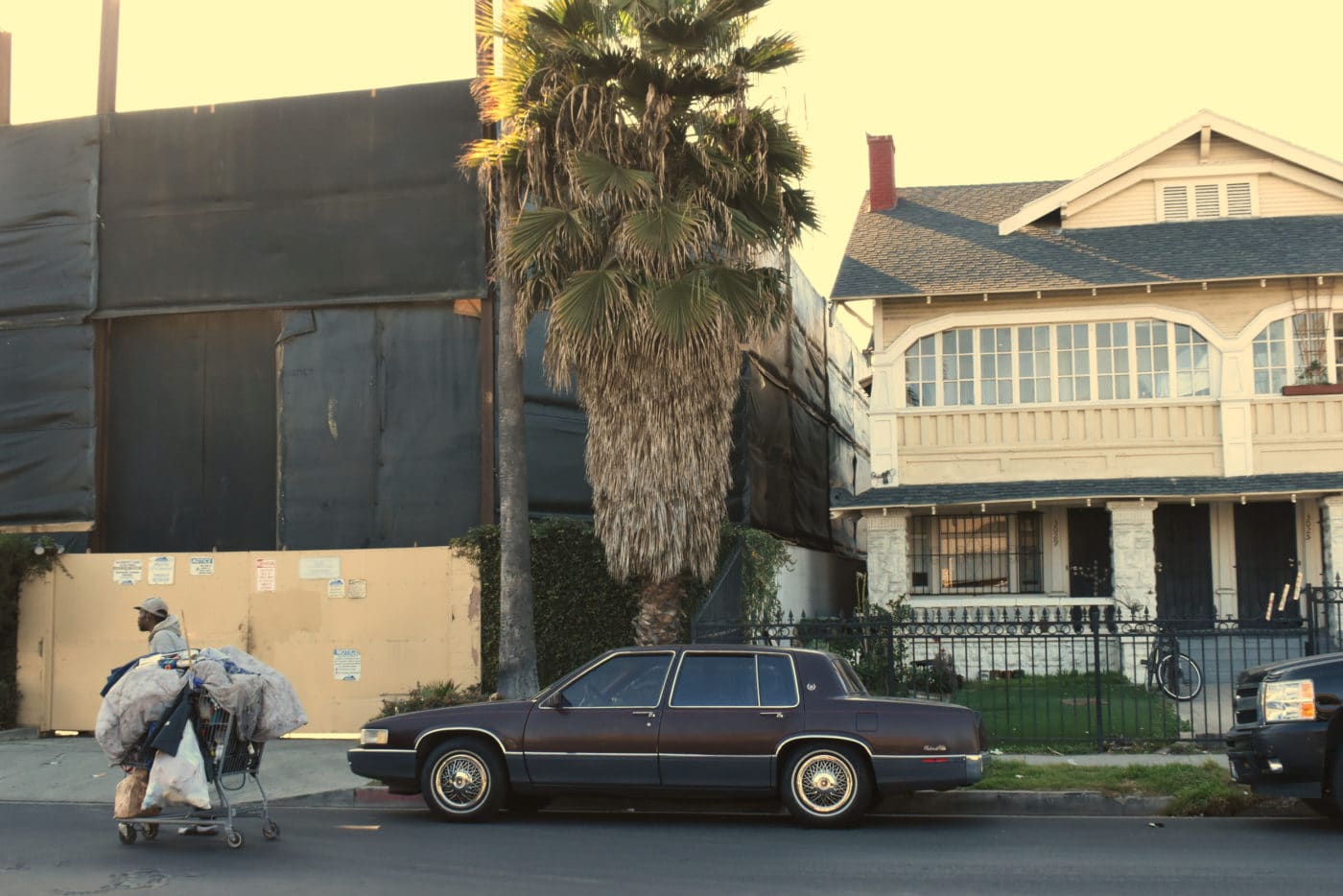[dropcap size=big]T[/dropcap]he 21 oil wells down the street from Marco Sanchez front door are named after one of the 12 apostles.
And last September, the St. James oil wells sprung a leak.
No one in the South Los Angeles neighborhood noticed until repair crews arrived at the gated facility. During their corrective work, a chemical odor snaked its way into the South L.A. neighborhood less than a mile from the University of Southern California.
“My throat was irritated, and it felt like someone was burning hot chilis. I thought my mom was cooking. She said I’m not doing that,” Sanchez says. “The smell lasted for a few hours and then it was gone.”
Down the street Harry’s Market store owner, Ben Mulugeta just opened his store on the same morning when he was choked up.
“Like burning. It was bad. Just like no smell but itching and burning,” Mulugeta says. “It tastes like bitter. On that day, I wanted to call 911.”
The drill site property is owned by the Archdiocese of Los Angeles and leased to AllenCo Energy who voluntarily closed their operation six years ago after state inspectors became ill from noxious fumes during a visit.
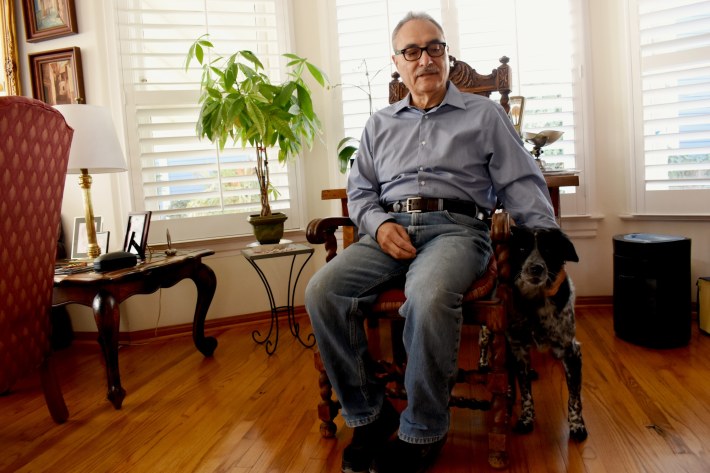
Waking up with a nosebleed
For years neighbors woke with nosebleeds. Their children complained of headaches and the official channels to report complaints seemed to go nowhere. Data was key, says organizer Hugo Garcia with Esperanza Community Housing and the People Not Pozos campaign, and residents meticulously documented the air quality around their homes and along with their health symptoms.
“This was all gathered by the people who live here and they continued to build that up,” said Garcia. “That was the momentum that got attention.”
This March, the California Geologic Management Division (CalGEM) ordered AllenCo Energy to cap its wells and close the site due to numerous violations, but the operators have appealed the order and with court closures in effect due to the coronavirus pandemic it’s unclear when the process will move forward.
Then one-day oily water rained down on the neighborhood.
“I’d testify myself if possible to share all the health issues residents have gone through over the years,” says Garcia.
Even shuttered, the site remains a nuisance. CalGEM reports on April 23, 2020 a minor leak was found at the site.
The Archdiocese of L.A. declined an interview for this article and previous attempts to engage them as the landlords of the drill site have gone nowhere for the residents.
In a statement, the Archdiocese of L.A. said they will “cooperate and work with the city and AllenCo to find an alternative use for the site that is in the best interest of the community, royalty holders, and all other stakeholders.”
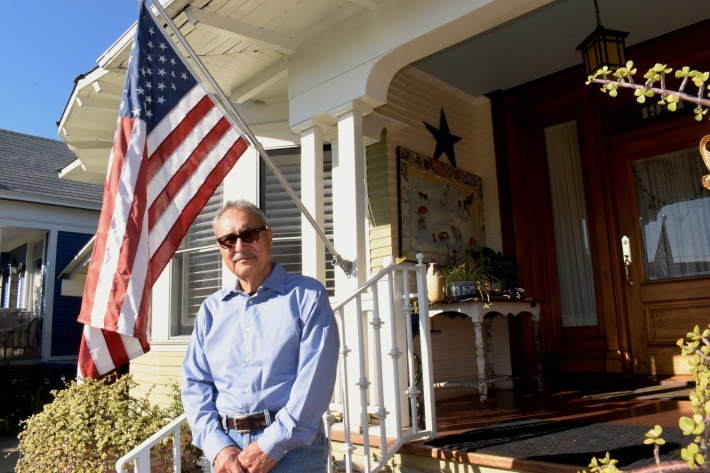
As a devout Catholic, Sanchez wonders why the church would not step forward to help the neighborhood.
“The Archbishop is responsible for all the facilities and all the churches they own,” says Sanchez. “If I was the Archbishop and have a plant that’s causing problems I would be concerned. Let’s rectify that and do something—anything.”
The smell of jasmine flowers and a ‘deafening din’
Less than a mile from AllenCo are the towering walls of the Jefferson Oil drill site, just across the street from QC Kelker’s front door.
While her neighbors say the loud industrial sounds and strong chemical odors have been a public nuisance for years, Kelker had little to complain about the oil operation.
Then one-day oily water rained down on the neighborhood.
“I came out and saw it hit the cars and my house and my neighbor’s house,” Kelker says. “I knocked on the door where the drillers are and they didn’t hear me. So I went around with a brick and knocked on the other door to find out what was going on.”
“Could my own miscarriages have been caused by these toxins?”
The Los Angeles County Fire Department reports the site experienced a malfunction in 2011 when the treated water rained down on the West Jefferson neighborhood.
Kelker says an employee from the oil company, Plains Exploration and Production Co (PXP), apologized and sent a cleanup crew to her home.
Kelker says, “They also gave me a coupon to clean my car.”
In 2012, PXP reported the drill site emitted 15.729 tons per year of carbon monoxide, nitrogen oxides, reactive organic gases, sulfur oxides, and total suspended particulates, along with toxic pollutants like benzene, ammonia, formaldehyde, and other pollutants.
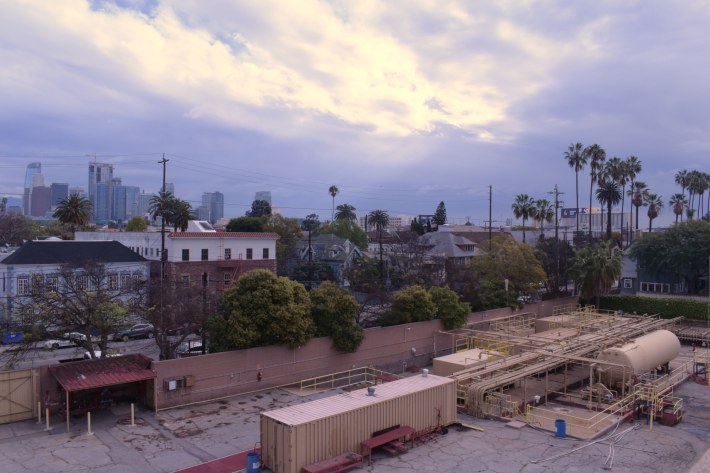
With cardboard wings, the children of the neighborhood dressed as canaries to bring attention to the drill site in 2015 and regularly residents packed public hearings to share their concerns about their health hazards.
“Could my own miscarriages have been caused by these toxins?” Jen Blue asked at L.A. City Hall during a January 2017 meeting before the zoning administrator where stakeholders were asked to share their experience living near the site.
Blue has lived in the neighborhood for 16 years and is the acting senior Pastor with Church of the Redeemer in South L.A.
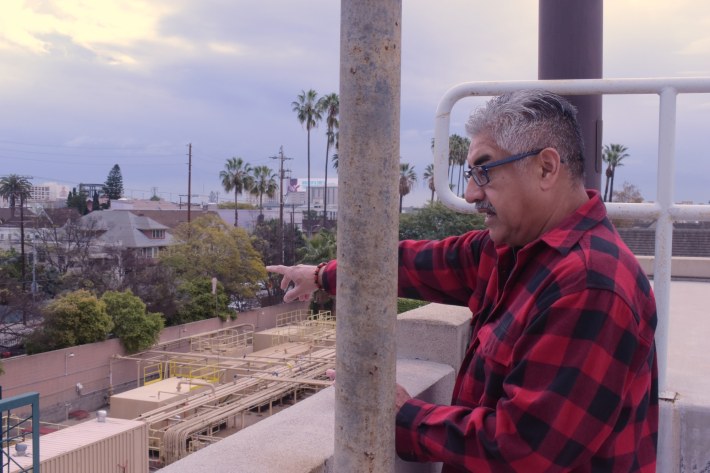
She’s painfully aware that chemicals used in oil drill sites contain endocrine disruptors, which are harmful to a woman’s reproductive system, and other women in the neighborhood have shared similar stories with her.
“This was healing for me to talk about the miscarriages at the public hearings, because it put a face to the impact,” Blue tells L.A. Taco.
Blue says while she doesn’t live near the AllenCo site, her children’s pre-school was around that site and before the pandemic her mother lived near another drill site not too far away.
“It feels like this web goes everywhere we go,” Blue says. “Right around in my neighborhood.”
By October 2017, the city’s petroleum administrator ordered the operators to install a new monitoring system to alert the public when toxic fumes escape the facility and a 45-feet tall sound wall to protect the neighborhood.
Maria Gonzales has lived in the University Park neighborhood for 25 years and says before the drill site closed six years ago headaches and nosebleeds were common among children. Neighbors who moved away would call her to say their children’s asthma or allergies would clear up.
The walls rose, but the strong rotten egg odor continued to spill into the neighborhood, say, residents, who said that was followed by an eerily strong jasmine-like odor.
That was a chemical pumped into the neighborhood by the drill operator to cover up other noxious fumes, but that jasmine chemical includes compounds known to cause developmental and reproductive side effects with rodents.
With its raised walls, the Jefferson Drill site was akin to a monolith.
Former resident Corrissa Pacillas Smith’s son was just a newborn trying to take a nap when they lived across the street from the site as large machines pounded into the earth.
“The metal would strike the ground so incredibly loud and even if I had all my windows closed we could hear it,” said Smith. “I call it the deafening din.”
‘Why are they still here?’
Last May, Sentinel Peak filed plans to abandon the Jefferson site and cap all 34 wells by 2022. The operators notified city planning that it would rather shutter the site than to update its site to meet new health standards.
The closure did not come easy.
Policy director Niki Wong with the nonprofit Redeemer Community Partnership says the campaign to close the site was built on sharing public testimony about impacts to their health, but also stating the obvious to the city.
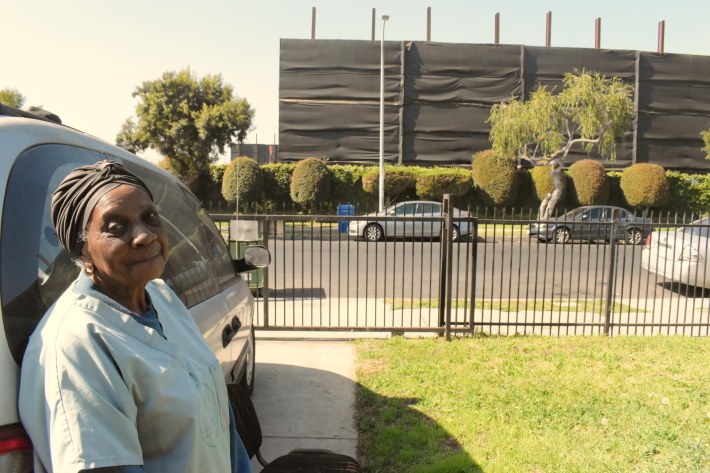
“It was staggering to us how much was going on there. It’s a full-on industrial site right in the middle of a residential neighborhood,” said Wong.
Executive Director Martha Dina Argüello with the nonprofit Physicians for Social Responsibility says it’s often a difficult case to make about urban oil drilling’s impact on people's health because there are so few studies on the topic.
“Oftentimes, these residents who live near oil drilling sites are left to share their personal anecdotes about their health,” Argüello says. “Because there’s so little research on urban oil drilling and the impact on their health.”
Last December, before the AllenCo site was ordered to shut down by the state, Garcia, the organizer with Esperanza Community Housing, asked a group of neighbors if they were interested in speaking with a reporter about their experience living near the drill site.
Maria Gonzales has lived in the University Park neighborhood for 25 years and says before the drill site closed six years ago headaches and nosebleeds were common among children. Neighbors who moved away would call her to say their children’s asthma or allergies would clear up.
“Falto de aire, asma, vómito, y cancer,” Gonzales says. She holds her hands a few inches apart and says in Spanish, “But not one doctor will say it’s because of the oil company. They won’t connect the two.”
“They expect us to wait or go along with the process, but when we see holes we’re going to patch them up,” says Garcia. “People got sick for so long and they just were so flagrant about that.”
Sentinel Peak Resources, the operators behind the Jefferson site, said it would cap its 34 wells by January 2022 and complete demolition by May 2022. But the project is behind schedule and only 17 percent completed and due to the coronavirus pandemic, the operators asked for a 90-day suspension, according to the planning department. Despite construction work being deemed “essential” in Los Angeles County.
L.A. City Planning spokesperson Nora Frost says the department “respects the operator’s decision to suspend abandonment activities. With that in mind, the department has requested that the operator keep the department apprised of any change in the abandonment timeline. The City reserves the right to approve of any change in timeline, change in milestones, and change in benchmarks given a legitimate justification from the oil drilling operator.”
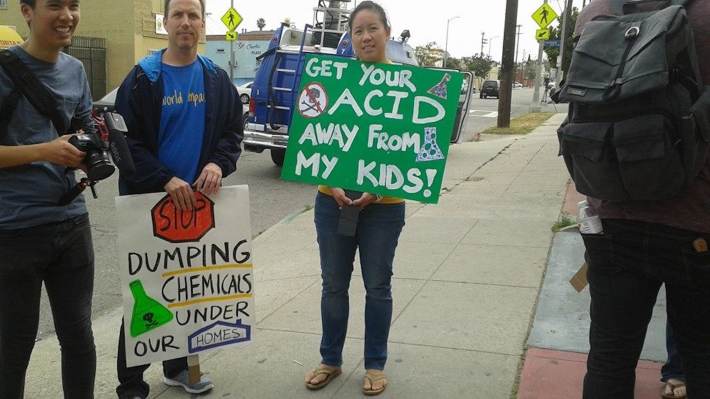
She adds multiple agencies including CalGEM, the Los Angeles Fire Department, and the South Coast Air Quality Management District all oversee the well abandonment process.
“It still poses a threat,” says Wong. “It’s still something that will be impacting people after and through the pandemic. Now more than ever when more things are being relaxed and exemptions are being made for the oil and gas industry, it feels like the ripe time for negligence to happen. It feels important to pay attention to that.”
Garcia says if it wasn’t for the residents stepping forward to help themselves none of the regulatory agencies would have taken notice. The COVID-19 lockdown does not mean anyone has stopped paying attention.
“They expect us to wait or go along with the process, but when we see holes we’re going to patch them up,” says Garcia. “People got sick for so long and they just were so flagrant about that.”
A vacant position and no one stepping up to take responsibility
The overarching goal for all the advocates against urban oil drilling in L.A. is a 2,500 setback or barrier around oil drill sites that would essentially make it nearly impossible for any to operate in densely populated neighborhoods.
Last summer, a report released by the Dept. of Public Works estimated implementing a 1,500-feet barrier around oil drill sites would cost the city $1.2 billion to $97.6 billion from the city taking the mineral rights from property owners and to payout the remaining 1.6 billion barrels of recoverable oil and gas reserves—not to mention an ongoing $1 million per year for several years pending lawsuits from the oil industry.
“Every year I hear about a neighbor who dies from respiratory cancer.”
The report recommends a 600-feet barrier for existing drill sites, but advocacy groups say that’s still too close to people’s homes. That report is currently being reviewed by the city attorney’s office.
Public Works says it cannot provide anyone for an interview on the report because the petroleum administrator’s position is vacant.
A petition from the environmental advocacy law group EarthJustice seeking to highlight the health hazards and environmental injustice from the Jefferson Oil drill site seems to capture the sentiment so many residents feel about the urban drilling situation: “The City of Los Angeles played an important role in the creation of the nuisance conditions” that residents experience across the region.
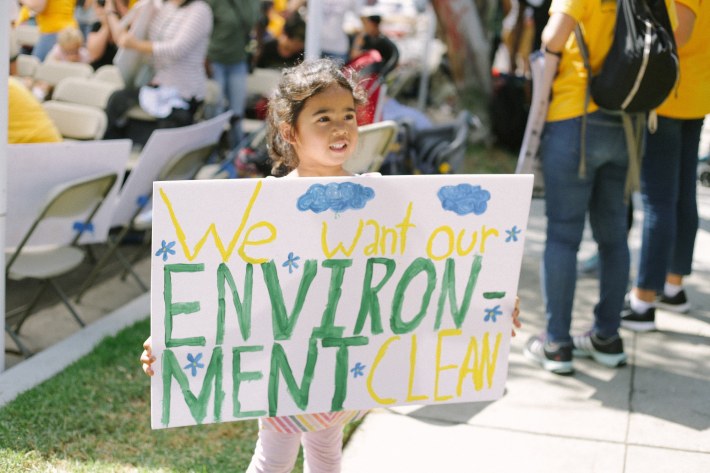
Without exaggeration, in the case of these wells in South Los Angeles, the silent killer is next door. It is not aware of the pandemic or any one person’s faith in a bureaucratic system to regulate the flow of toxic chemicals.
On the other side of that wall? An already marginalized community having to overcome yet another systemic hurdle thrown at them.
Wong, who is also a resident in the South Los Angeles community affected by the wells sums up the severity of the situation.
“Every year I hear about a neighbor who dies from respiratory cancer.” She echoes the same dire question over and over when detailing their work against urban drill sites: “Why are they still here? It just doesn’t make sense.”
-
A previous version of this article referred to the petroleum administrator who ordered an enclosure wall around the Jefferson site in October 2017. It was the Zoning Administrator.
The wall ordered to be built around the site was never built, but instead, a temporary sound wall was erected in the summer of 2019.
The planning department says they have not received any odor complaints since January 2017, but residents say they continued to smell noxious odors from the site as recent as November 2019.
